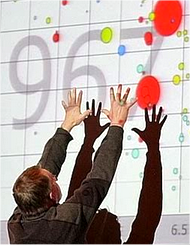Lecture: Introduction to Interactive-Visual Data Analysis

| Lecturer | Prof. Dr. Jürgen Bernard |
| Teaching Language | English |
| Level, ECTS | MSc (3ECTS) PhD (DSI) (1ECTS) |
| Academic Semester | Fall 2021 |
| Time and Location | Tuesday: 12:15 - 13:45 (starting September 28). AFL-F-121 (UZH policy: no entry without Covid-19 certificate). Zoom, for students who cannot participate in person. |
| Digital Backups | Slides will be on OLAT, additional course material will be as described below. There is NO RECORDING of the lecture, as this is an interactive course requiring live participation. |
| Start Date | 28.09.2021 |
| Exam Date | 21.12.2021 |
| Exam Location | KOL-F-101 |
| Course Material | Coursebook (Visualization Analysis and Design, Tamara Munzner) Research papers (as announced) |
| Grading | Two parts, both need to be passed separately P1: 1/6 active participation across lectures, 1/6 homework1, 1/6 homework2 P2: 1/2 written exam |
| Office Hours | Prof. Dr. Jürgen Bernard: email for appointments, BIN 5.E.15 |
Course Pitch
General Description This course introduces fundamental concepts and techniques of interactive-visual data analysis (IVDA). The main focus is on the combination of automatic data analysis methods with interactive visual interfaces as well as on their interplay to facilitate data analysis goals. As such, IVDA is particularly suited to leverage the strengths of both humans and machines in a human-in-the-loop data analysis process. Associated research fields are Information Visualization, Visual Analytics, and Interactive Machine Learning.
Learning Outcome
In the first part, students will learn basic characteristics of data types and data attributes (WHAT), as well as data analysis tasks (WHY). Further, students will learn basic design skills about HOW data can be transformed into visual structures and which types of visualization techniques are meaningful design choices for given data types and analysis at hand. Students will also learn fundamental interaction techniques, as well as concepts for the composition of views in data analysis systems.
In the second part, students will gain an understanding about how data analysis can benefit from both having a human and a (machine learning) model in the loop, following the goal to gain knowledge from data. Along these lines, students will learn about the strengths (and weaknesses) of human and machines, as well as about combining these complementary strengths effectively, as described in Visual Analytics methodology. In detail, students will learn examples for interactive data preprocessing, for human-centered unsupervised machine learning, as well as for human-centered semi-supervised and supervised machine learning. Finally, the course introduces approaches that allow training personalized machine learning models and conduct personal data analytics.
Target Groups This module is designed for MA students (POC, DS). There are no enforced prerequisites. It would be possible for students in other disciplines to take this course with only minimal programming background. It is useful if students have already passed the Data Visualization Concepts lecture but once again there are no enforced prerequisites.
This course does not teach visualization libraries: most students will pick up Tableau, D3 (Javascript), ggplot (R), or python-based visualization tooling on their own.
Required Reading Visualization Analysis and Design, Tamara Munzner (A K Peters Visualization Series, CRC Press, 2014) is the course textbook. Required reading also includes selected papers as outlined below.
Topic Overview
|
21.09.2021
|
|
no class - start with required reading
|
|
28.09.2021
|
W01
|
Introduction to Introduction to IVDA
|
|
05.10.2021
|
W02
|
Data Types and Analysis Tasks
|
|
12.10.2021
|
W03
|
Marks, Channels, and Visualization Guidelines
|
|
19.10.2021
|
W04
|
Interaction Techniques and View Composition |
|
26.10.2021
|
W05
|
-- no lecture -- (IEEE VIS conference)
|
|
02.11.2021
|
W06
|
Advanced Visualization Techniques
|
|
09.11.2021
|
W07
|
Users, Data Scientists, and Problem-Driven Design
|
|
16.11.2021
|
W08
|
Introduction to Visual Analytics
|
|
23.11.2021
|
W09
|
Data Transformations and Visual Preprocessing
|
|
30.11.2021
|
W10
|
ML4VIS and Data Explorers
|
|
07.12.2021
|
W11
|
VIS4ML and Model Explainers
|
|
14.12.2021
|
W12
|
Human-Centered Data Analysis
|
|
21.12.2021
|
W13
|
Exam
|
2021-09-21 - No class
start with the required reading (VAD book) instead
2012-09-28 - Week 1: Introduction to Introduction to Interactive Visual Data Analysis
Required Reading (pre-class)
- VAD book Chapter 1. What's Vis, and Why Do It?
In-class Agenda
- Welcome to the class!
- Why take this course? - some considerations
- Course logistics - organizational stuff
- Introduction - Introduction to Interactive Visual Data Analysis
- Vis-Fails
In-class Application Demo
LayoutExOmizer: Interactive Exploration and Optimization of 2D Data Layouts Philipp Schader, Raphael Beckmann, Lukas Graner, Jürgen Bernard. VMV, Eurographics, 2021. Presenter: Philipp Schader |
|
Further Reading
- [VIS Design Principles]: Semiology of Graphics, Jacques Bertin, Gauthier-Villars 1967, EHESS 1998
- [VIS Design Principles]: The Visual Display of Quantitative Information. Edward R. Tufte. Graphics Press, 1983.
2021-10-05 - Week 2: Data Types and Analysis Tasks
Required Reading (pre-class)
In-class Agenda
- What to visualize?: data types
- Why visualize?: analysis tasks
- Exercises/Questions
In-class Application Demo
Visual-interactive Exploration of Interesting Multivariate Relations in Mixed Research Data Jürgen Bernard, Martin Steiger, Sven Widmer, Hendrik Lücke-Tieke, Thorsten May, Jörn Kohlhammer. Computer Graphics Forum (CGF), 2014. Presenter: Jürgen Bernard |
|
Further Reading
- [Data and Tasks]: The eyes have it: A task by data type taxonomy for information visualizations - B. Shneiderman - 1996
- [VIS Introduction]: Readings in Information Visualization: Using Vision To Think, Chapter 1 - Stuart K. Card, Jock Mackinlay, and Ben Shneiderman. Morgan Kaufmann - 1999
- [Data and Tasks]: Information Visualization and Visual Data Mining - Daniel Keim - 2002
- [Interaction Tasks]: Toward a Deeper Understanding of the Role of Interaction in Information Visualization - Yi, Kang, Stasko, Jacko – 2007
- [Time Series Data and Tasks]: Visualization of Time-Oriented Data - Wolfgang Aigner, Silvia Miksch, Heidrun Schumann, Chris Tominski. Springer - 2011
2021-10-12 - Week 3: Marks, Channels, and Visualization Guidelines
Required Reading (pre-class)
In-class Agenda
- How to visualize? P1: marks and channels
- Visualization guidelines
- Exercise/Questions
In-class Application Demo
| Tableau is an interactive data visualization tool for spreadsheet data and more. Tableau builds upon principles of the Polaris paper, with a table-based algebra for graphical presentations of tabular data. Presenter: Clara-Maria Barth |
|
Further Reading
- [VIS Design Principles]: Semiology of Graphics, Jacques Bertin, Gauthier-Villars 1967, EHESS 1998
- [VIS Design Principles]: The Visual Display of Quantitative Information. Edward R. Tufte. Graphics Press, 1983.
- [Crowdsourced VIS Judgements]: Heer, J. and Bostock, M., 2010, April. Crowdsourcing graphical perception: using mechanical turk to assess visualization design. SIGCHI conference on human factors in computing systems (pp. 203-212)
- [Glyph Design]: Borgo, R., Kehrer, J., Chung, D.H., Maguire, E., Laramee, R.S., Hauser, H., Ward, M. and Chen, M., 2013, May. Glyph-based Visualization: Foundations, Design Guidelines, Techniques and Applications. STAR Report
2021-10-19 - Week 4: Interaction Techniques and View Composition
Required Reading (pre-class)
- VAD book Chapter 11: Manipulate View
- VAD book Chapter 12: Facet into Multiple Views
- VAD book Chapter 14: Embed: Focus+Context
In-class Agenda
- Hans Rosling ted talk (skipped due to technical issues)
- Principles of Interaction Design
- How to visualize? P2: low-level interaction techniques
- How to visualize? P2: view composition and higher-level interactions
- Homework introduction
- Pointer: Interactive Tableau Session P2 (try it out)
In-class Video Demo (skipped)
In his video ted talk, Hans Rosling tells a interactive and visual data story about the evolution of the health situation of all states on Earth in the last 200 years. In only few minutes, he refers to 120.000 numbers. You've never seen data presented like this. With the drama and urgency of a sportscaster, statistics guru Hans Rosling debunks myths about the so-called "developing world." Presenter: Hans Rosling (1948-2017). Global health expert and data visionary |
|
Further Reading
- [General Design Principles] Norman, D., The design of everyday things: Revised and expanded edition. Basic books. 2013
- [VDA book alternative] Interactive Visual Data Analysis. Christian Tominski and Heidrun Schumann. AK Peters Visualization Series. CRC Press. 2020
2021-10-26 - Week 5: NO LECTURE (Reading, Homework Week)
Required Reading (pre-class)
- VAD book Chapter 7: Arrange Tables
- VAD book Chapter 8: Arrange Spatial Data
- VAD book Chapter 9: Arrange Networks and Trees
- Polaris: A System for Query, Analysis and Visualization of Multidimensional Relational Databases. Chris Stolte and Pat Hanrahan. Proceedings of IEEE InfoVis 2000. [research paper, intellectual foundation of the Tableau software]
In-class Agenda
- No lecture this week (do the required reading instead)
- Homework
- Participate at IEEE VIS 2021 (recommended, not expected)
IEEE VIS 2021 Conference
IEEE VIS will be the year’s premier forum for advances in theory, methods, and applications of visualization and visual analytics. The conference will convene an international community of researchers and practitioners from universities, government, and industry. We will receive the Best Paper Award for our paper called IRVINE: Using Interactive Clustering and Labeling to Analyze Correlation Patterns: A Design Study from the Manufacturing of Electrical Engines. |
|
Further Reading
- [IEEE VIS Best Paper] IRVINE: Using Interactive Clustering and Labeling to Analyze Correlation Patterns: A Design Study from the Manufacturing of Electrical Engines. Joscha Eirich, Jakob Bonart, Dominik Jäckle, Michael Sedlmair, Ute Schmid, Kai Fischbach, Tobias Schreck, Jürgen Bernard. IEEE VIS, TVCG, 2021.
2021-11-02 - Week 6: Advanced Visualization Techniques
Required Reading (pre-class)
- VAD book Chapter 7: Arrange Tables
- VAD book Chapter 8: Arrange Spatial Data
- VAD book Chapter 9: Arrange Networks and Trees
- Polaris: A System for Query, Analysis and Visualization of Multidimensional Relational Databases. Chris Stolte and Pat Hanrahan. Proceedings of IEEE InfoVis 2000. [research paper, intellectual foundation of the Tableau software]
In-class Agenda
- Live presentation of homework one-pagers
- Overview of advanced visualization techniques
- In-class Application Demo
In-class Application Demo: LineUp
LineUp is a Visual Analysis tool for the analysis of Multi-Attribute Rankings and has been published at the IEEE VIS conference in 2013. LineUp has received the IEEE VIS Best Paper Award. Students are also recommended to go to the LineUp demo page. Presenter: Jenny Schmid |
|
Further Reading
- [Multivariate Data]: Samuel Gratzl, Alexander Lex, Nils Gehlenborg, Hanspeter Pfister, Marc Streit - LineUp: Visual Analysis of Multi-Attribute Rankings - IEEE TVCG, 2013
W07 - Users, Data Scientists, and Problem-Driven Design
Required Reading (pre-class)
- VAD book Chapter 4: Analysis: Four Levels for Validation
- Paper: Anamaria Crisan; Brittany Fiore-Gartland; Melanie Tory. Passing the Data Baton: A Retrospective Analysis on Data Science Work and Workers. IEEE Transactions on Visualization and Computer Graphics. 2021.
In-class Agenda
- Data Scientists & Users
- Validation of VIS Designs using the Nested Model
- Design Studies
- In-class Application Demo
In-class Application Demo: IRVINE
IRVINE a Visual Analytics system which facilitates the analysis of previously unknown errors in the manufacturing of electrical engines by leveraging interactive visual clustering and interactive data labeling. The design study conducted together with experts from BMW has received the IEEE VIS Best Paper Award 2021 and is published in IEEE Transactions on Visualization and Computer Graphics. Presenter: Joscha Eirich |
|
Further Reading
- Paper: Sedlmair M, Meyer M, Munzner T. Design study methodology: Reflections from the trenches and the stacks. IEEE Transactions on Visualization and Computer Graphics. 2012.
W8 - Introduction to Visual Analytics
Required Reading (pre-class)
- Paper: Knowledge Generation Model for Visual Analytics. Dominik Sacha, Andreas Stoffel, Florian Stoffel, Bum Chul Kwon, Member, Geoffrey Ellis and Daniel A. Keim. IEEE Transactions on Visualization and Computer Graphics. 2014.
In-class Agenda
- In-class Application Demo
- Knowledge Generation Process
- Data Transformation Processes
- Humans and Machines
- Synthesis: Visual Analytics
In-class Application Demo: Topic Modelling with SpecEx
Mennatallah El-Assady presents Visual Analytics solutions for complex textual document collections. Menna uses topic modeling algorithms in a text mining process, coupled with interactive visual interfaces so that humans are kept in the loop. In the demo, she shows that users' input can be useful before, while, and after an iterative topic modeling method is executed. Presenter: Mennatallah El-Assady |
|
Further Reading
W9 - Data Transformations and Visual Preprocessing
Required Reading (pre-class)
- Paper: Research directions in data wrangling: Visualizations and transformations for usable and credible data. Kandel S, Heer J, Plaisant C, Kennedy J, Van Ham F, Riche NH, Weaver C, Lee B, Brodbeck D, Buono P. Information Visualization. 2011
In-class Agenda
- Aspects of Dirty Data
- Data Transformations
- Visual Preprocessing Applied
- In-class Application Demo
In-class Application Demo: Preprocessing of multivariate time series
Heiko Reinemuth presents a VA system that includes a) an interactive workflow creation tool to build cascades of preprocessing operations and b) an interactive data analysis and visual comparison component to assess uncertainty and preprocessing quality. Co-authors of the EuroVis conference and CGF journal publication are J. Bernard, M. Hutter, H. Reinemuth, H. Pfeifer, C. Bors, and J. Kohlhammer. Presenter: Heiko Reinemuth (former student and co-author of Prof. Bernard) |
|
Further Reading
W10 - ML4VIS and Data Explorers
Required Reading (pre-class)
- VAD book Chapter 13: Reduce Items and Attributes
In-class Agenda
- "ML4VIS" with an emphasis on data-centered VIS challenges
- Visual Analytics based on Clustering
- Visual Analytics based on Dimensionality Reduction
- Self-organizing Maps (SOM) special
- In-class Application Demo
In-class Application Demo
SOMFlow: exploratory cluster analysis with Self-Organizing Maps (SOM) Dominik Sacha presents a multi-stage VA approach for iterative cluster refinement using SOMs to analyze time series data. SOMFlow is a visual platform to analyze intermediate results, adapt the underlying computations, iteratively partition the data, and to reflect previous analytical activities. Co-authors of the TVCG journal publication (2018) are Sacha, D., Kraus, M., Bernard, J., Behrisch, M., Schreck, T., Asano, Y., Keim, D. Presenter: Dr. Dominik Sacha(Siemens), former PhD student at the University of Konstanz. |
|
Further Reading
- Paper: Visual Cluster Analysis of Trajectory Data With Interactive Kohonen Maps. Schreck, T., Bernard, J., Von Landesberger, T., Kohlhammer, J. Information Visualization, Palgrave Macmillan, 2009
- Paper: MotionExplorer: Exploratory Search in Human Motion Capture Data Based on Hierarchical Aggregation. Bernard, J., Wilhelm, N., Krüger, B., May, T., Schreck, T., Kohlhammer, J. TVCG, 2013
- Paper: Sacha D, Kraus M, Bernard J, Behrisch M, Schreck T, Asano Y, Keim DA. Somflow: Guided exploratory cluster analysis with self-organizing maps and analytic provenance. TVCG, 2018
W11 - VIS4ML and Model Explainers
Required Reading (pre-class)
- Paper: Hohman F, Kahng M, Pienta R, Chau DH. Visual analytics in deep learning: An interrogative survey for the next frontiers. IEEE Transactions on Visualization and Computer Graphics (TVCG). 2018.
In-class Agenda
- Supervised ML Special
- VIS4ML - Using VIS/VA to support ML
- Live Application - VIAL – Visual Interactive Data Labeling
- In-class Application Demo
In-class Application Demo: Visual Observation of Data Labeling Runs
Raphael Beckmann presents an interactive visual analysis tool for the (retrospective) observation of data labeling runs. The approach provides multiple linked views for the visual assessment of data labeling quality and the choices the applied instance selection strategy. Presenter: Raphael Beckmann is a student member of the IVDA group. |
|
Further Reading
- Paper: T. Mühlbacher, H. Piringer. A partition-based framework for building and validating regression models. IEEE Transactions on Visualization and Computer Graphics (TVCG). 2013
- Paper: J. Bernard, M. Zeppelzauer, M. Sedlmair, and W. Aigner: VIAL – A Unified Process for Visual-Interactive Labeling. The Visual Computer Journal (TVCJ). 2018.
W12 - Human-Centered Data Analysis
Required Reading (pre-class)
- none
In-class Agenda
- Human-Centered Artificial Intelligence (HCAI)
- Introduction to Human-Centered Data Analysis
- Types of Explicit User Feedback
- In-class Application Demo
In-class Application Demo: Personalized Similarity and Personalized Classification
Christian Ritter presents two human-centered data analysis tools. The first allows users to express their personal notion on the similarity of soccer players, the second supports users in labeling personal music collections. In both cases a machine learning model is trained iteratively that can also be analyzed interactively. The Soccer and the Music tool have both been published in the visual analytics community (see Further Reading below). Presenter: Christian Ritter is a former student and co-author of Prof. Bernard. |
|
Further Reading
- Book: Ben Shneiderman. Human-Centered AI. Oxford University Press. 2022
- Paper: Bernard, J., Ritter, C., Sessler, D., Zeppelzauer, M., Kohlhammer, J., Fellner, D. Visual-Interactive Similarity Search for Complex Objects by Example of Soccer Player Analysis. IVAPP / VISIGRAPP. 2017
Paper: Personalized Visual-Interactive Music Classification. Christian Ritter, Christian Altenhofen, Matthias Zeppelzauer, Arjan Kuijper, Tobias Schreck, and Jürgen Bernard, EuroVA @ EuroVis (EuroGraphics). 2018











